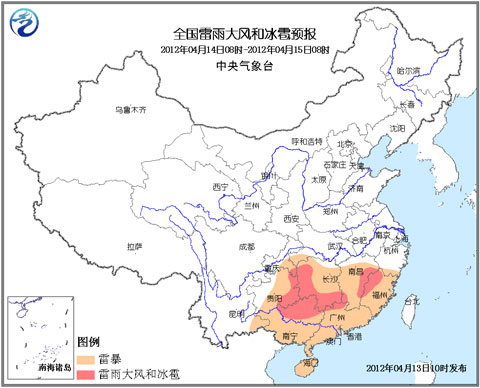Recently, most of the south and south of the Yangtze River have been raining heavily, with obvious heavy rainfall and strong convective weather in most of the south of the Yangtze River, north-central South China and southern Guizhou. It is expected that there will still be heavy rainfall in most areas tomorrow (14th to 15th), and there will be strong convective weather in some areas.
In recent days, the rainfall from Jiangnan to northern China is relatively large. The monitoring shows that from April 10 to 12, the rainfall in the south of Jianghan, the central and northern parts of the south of the Yangtze River, the northern part of South China and the eastern part of Chongqing, and the northeastern part of Guizhou was 30-60 mm. The rainfall in the north of Hunan, the central and eastern Jiangxi, and the northwestern part of Fujian reached 80 ~ 150 mm, Jiangxi Lichuan and Fujian gloss 180 to 198 mm.
At the same time, there were obvious strong convective weather processes in most of the south of the Yangtze River, north-central South China and southern Guizhou. Among them, there are hail in 19 counties and cities in Guizhou, the largest hail in Jinping County is 50 mm in diameter, and Taijiang County in southeastern Guizhou suffers from strong winds with an instantaneous wind speed of 26.8 m/s; in 8 counties and cities in Jiangxi, there are more than 8 thunderstorms. Yongfeng 29 m / s (11) is the largest, hail maximum diameter is 15 mm; Guangxi melt water has a diameter of 20 mm hail; Hunan 4 counties and cities have hail, Wugang hail maximum diameter of 20 mm, 6 counties There is a transient wind in the city. The maximum wind force in Guiyang is 24 m/s; the diameter of the Yuxi hail in Fujian is 30 mm, and the thunderstorm winds reach 7-9; some cities and counties in Guangdong have a thunderstorm and strong winds of 8-11, and the largest gust in Qingyuan is 31.1 m. / sec (11 levels), maximum 1 hour rainfall 84.1 mm.
Yesterday, the precipitation range in Jiangnan South China and other places has weakened, but some areas still have strong precipitation. From 5 pm to 5 o'clock yesterday, most of the south of the Yangtze River, central and eastern Guizhou, Chongqing and other places have light rain (2-10 mm). The ground falls to heavy rain (10-40 mm); thunderstorms occur in central and eastern China, with a rainfall of 10-50 mm, and the central part of Guangdong reaches 60-107 mm.
The Central Meteorological Observatory predicts that there will be a strong rainfall process in Jiangnan and South China, and there will be heavy rains in some areas, accompanied by strong convective weather. Among them, there are small to moderate rains or showers in the southwestern part of the southwest, south-central Jianghan, southwestern Jianghuai and south of them. Among them, southeastern Tibet, eastern Guizhou, western and eastern Hunan, central Jiangxi, northwestern Guangxi, western Fujian, There are heavy rains (25-40 mm) in parts of southwestern Zhejiang and other places; some areas in eastern Guizhou, western Hunan, southwestern Jiangxi, northwestern Fujian, and northwestern Guangxi have short-term heavy precipitation; Thunderstorms or hail weather. 
The national thunderstorm gale and hail forecast map from 8:00 to 15:00 on the 14th
At present, the early rice planting in Hunan, Jiangxi and southern Zhejiang has entered the end, and the central part of Zhejiang has entered the peak of planting. Heavy convective weather such as heavy rain, hail and short-term thunderstorms and winds have caused rice seedling growth in parts of southern Hunan, eastern Guangxi, central and western Guangdong, southeastern Yunnan, southern Guizhou and other places, as well as rapeseed flowering pods, flue-cured tobacco and other on-site crops and tea gardens. The orchard was adversely affected.
Experts reminded that South China has entered the pre-flood period, strong rainfall and strong convective weather such as thunder, wind and hail in Jiangnan South China and other places will gradually increase. All localities need to pay close attention to the weather changes, and do a good job of urban and rural accumulation caused by heavy rainfall. Mountain torrents, landslides, mudslides, and countermeasures against strong convective weather disasters such as lightning, hail and short-term winds. In terms of agricultural production, it is necessary to clear the ditch in time after the rain to ensure the smooth progress of spring sowing and the normal growth of crops; the rapeseed area should strengthen the flower field management, promote the growth of pods and the formation of yield; the rice area should strengthen the management of water and fertilizer in Putian and strive to cultivate strong seedling.
Led Emergency Blub Light, Blackout Backup Emergency Bulb,Backup LED Light Bulb
Guangdong Dp Co., Ltd. , https://www.lightdp.com